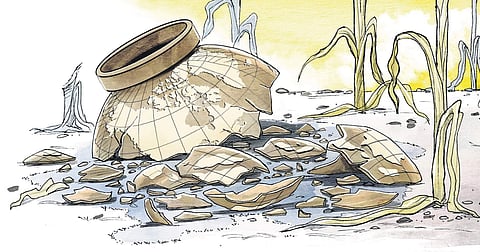

There is perhaps no immediate existential threat our country faces that is more dire than water scarcity. Global and domestic efforts are looming under the shadow of becoming a textbook case of too little, too late. However, the recent push under the Jal Shakti Abhiyan has finally set the wheels turning to counter depleting levels of available water resources. Nevertheless, there is a need for a long-term scientific approach to the issue. Institutional changes are the need of the hour if we wish to sustain the future benefits of Jal Shakti Abhiyan and go beyond reactionary policy.
Groundwater accounts for only 433 billion cubic metres (BCM) of the total 1,123 BCM of available water, yet dependence on groundwater remains disproportionately high. Irrigation is currently the biggest consumer as it uses 89% of all groundwater extracted; the 9% extracted for domestic use accounts for 50% of urban water usage and 85% of rural water usage. Despite this there is a lack of concerted action to address the extraordinarily high consumption by the agriculture sector. The government should focus on providing elasticity in the variety of low-water-consumption crops that farmers can opt to grow while simultaneously disincentivising water-intensive crops like sugarcane. Basmati rice especially has resulted in India becoming the biggest virtual exporter of water; on the contrary, China has transformed itself into one of the top virtual importers of water by resorting to the import of water-intensive crops like soya.
The government must also consider incentivising scientific methods to grow water-intensive crops sustainably as was done with the use of direct seeded rice in Punjab that resulted in water savings of up to 30% as it did not require puddling. Providing millets, which requires less water and other inputs, in mid-day meals will promote its cultivation and ensure better nutrition; while more expensive than rice there are long-term benefits to be gained. Furthermore, encroachments on river banks and flood plains must be strictly dealt with to ensure that they can be rejuvenated and thereby reduce the stress on groundwater reserves.
On the contrary, electricity and fertiliser subsidies have incentivised farmers to grow water-intensive crops. Cheap access to electricity and other inputs have allowed for the cultivation of crops in areas having low productivity, requiring even greater amounts of water as pointed out in the Economic Survey 2018-2019. Similarly smaller landholdings that cannot sustain an economy of scale require a disproportionate amount of water. Further, considering that water conservation fee may be levied on agriculture, such a move may become yet another subsidy to be shouldered by the state in line with previous trends. But such subsidies remain one of the few ways to financially incentivise agriculture especially in light of depreciating prices fostered by a pro-consumer approach.
The NITI Aayog’s Composite Water Management Index Report, 2019, highlighted the potential consequences of not addressing the issue by 2030 or at least of not forestalling it. It projected, inter alia, that 6% of the GDP will be lost by 2050 at the current rate, the MSME sector will be affected both directly and indirectly, and 70% of thermal power plants will face a water crisis—in fact it has already started. Moreover other indirect effects of water scarcity such as desertification and land degradation will lead to the creation of a vicious cycle. This juxtaposition is in many ways a microcosm of India’s dilemma. One wonders if schemes like ‘Har Ghar Jal’ and ‘Har Khet Ko Pani’ are a case of putting the cart before the horse.
The Jal Shakti Abhiyan is a commendable and necessary step but it must not serve as a mere stop-gap arrangement. Rather it must be a component of a wider Drought Resilience, Adaptation and Management Policy (DRAMP), a framework that was adopted in the 13th COP of the UNCCD. In the long run India can’t afford to be reactionary and instead must have in place mechanisms that are proactive and engage in sustainable long-term solutions.
There still remain certain irregularities in the institutional framework. One of them is a colonial vestige in the form of the Indian Easements Act, 1882, which prevents the creation of easementry rights over ground water, and allows for the easement for a polluting activity that has been done so for 20 years or more.
The lack of prescription, i.e. private rights over ground water in practical application allows for industries to drain water greater than their rightful share due to the fluid nature of water. The case of Plachimada in Kerala is one such instance which led to a David versus Goliath confrontation between the people and Coca Cola. This is despite the fact that in M C Mehta vs Kamal Nath, the apex court first invoked the Public Trust Doctrine (PTD) and declared it to be part of the law of the land. However, largely, the principle is echoed only in courtrooms. Lack of application of PTD has meant that water resources have not been democratised and decentralised.
The failure of the government to pass the National Water Framework Law has exacerbated the issue and delayed urgent reforms. In light of this I would be introducing legislation to amend the Easements Act and ensure that industries and especially corporates are not at liberty to exploit and pollute resources, and that water is democratised and is truly a right of everyone who depends on it. It is time to do away with this colonial vestige.
Social and institutional changes need to accompany government efforts. Putting in place mere stop-gap arrangements would be to simply replicate previous efforts. Radical and comprehensive reforms are the need of the hour. (Assisted by Noel Therattil, LAMP Fellow)
Lavu Sri Krishna Devarayalu
YSRCP MP from Narasaraopet, Andhra Pradesh
Email: krishna.lavu@yahoo.in